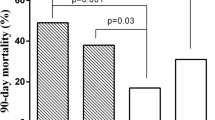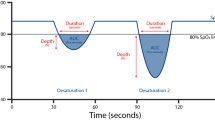Abstract
The goals of management of patients with respiratory failure include improving arterial oxygenation with PEEP and red cell transfusion to maintain oxygen carrying capacity, both of which contribute to improving tissue oxygen delivery. However, standard CPD-stored blood is rapidly depleted of 2,3 diphosphoglycerate (2,3 DPG) and ATP, with resultant inadequacy of the red cell oxygen transport function. In 15 patients requiring mechanical ventilation with PEEP whose initial Hct≤35%, we studied the effect of transfusion of 7 ml/kg of CPD-stored packed red blood cells on hemodynamic and oxygen delivery variables, pulmonary venous admixture (QA/QT), and erythrocytic P50, 2,3 DPG and ATP concentrations. Hemodynamics were not significantly altered by transfusion. 2,3 DPG decreased significantly from 14.5±1.1 to 13.1±1.5 mcmol/g Hb (mean±SD, p<0.05). There was no significant change in P50 or ATP. QA/QT rose significantly, from 20.1±7.8 to 28.9±12.3% (mean±SD, p<0.02). In our patients, an increase in arterial oxygen content obtained by transfusion was not followed by any associated decrease in cardiac work, as implied by solution of equations for oxygen delivery and oxygen consumption. The rise in QA/QT is undesirable in patients requiring PEEP, since it complicates management of their mechanical ventilatory support.
Similar content being viewed by others
References
Asmundsson T, Kilburn KH (1969) Survival of acute respiratory failure: a study of 239 episodes. Ann Intern Med 70:471
Bryan-Brown C (1980) Gas transport and delivery. In: Critical care: state of the art I. Society of Critical Care Medicine. Fullerton, CA
Moore GL, Ledford ME, Brooks DE (1978) The distribution and utilization of adenine in red blood cells during 42 days of 4C storage. Transfusion 18:538
Grenvik A (1966) Respiratory circulatory and metabolic effects of respiratory treatment: a clinical study in postoperative thoracic surgical patients. Acta Anaesthesiol Scand 19:(S)1
Sheldon GF (1979) Disphosphoglycerate in massive transfusion and erythropoiesis. Crit Care Med 7:407
Valeri CR, Rorth M, Zaroulis CG, Jakubowski MS, Vescera SV (1974) Physiologic effects of transfusing red blood cells with high or low affinity for oxygen to passively hyperventilated anemic baboons. Systemic and cerebral oxygen extraction. Ann Surg 180:106
Weisel RD, Dennis RC, Manny J, Mannick JA, Valeri CR, Hechtman HB (1978) Adverse effects of transfusion therapy during abdominal aortic aneurysmectomy. Surgery 83:682
Lichtman MA, Cohen J, Young JA, Witbeck AA, Murphy M (1974) The relationship between arterial oxygen flow rate, oxygen binding by hemoglobin and oxygen utilization after myocardial infarction. J Clin Invest 54:501
Oski RA, Gottlieb AJ, Miller WW, Delivoria-Papadopoulos M (1970) The effect of deoxygenation of adult and fetal hemoglobin on the synthesis of red cell 2,3 diphosphoglycerate and its in vivo consequences. J Clin Invest 49:400
Valeri CR, Collins FB (1971) Physiologic effects of 2,3 DPG depleted red cells with high affinity for oxygen. J Appl Physiol 31:823
Shibutani K, Komatsu T, Kubal K, Sanchala V, Kumar V, Bizzarri D (1983) Critical level of oxygen delivery in anesthetized man. Crit Care Med 11:640
Cain SM (1977) Oxygen delivery and uptake in dogs during anemic and hypoxic hypoxia. J Appl Physiol 42:228
Mohsenifar Z, Goldbach P, Tashkin DP, Campisi DJ (1983) Relationship between O2 delivery and O2 consumption in the adult respiratory distress syndrome. Chest 84:267
Dennis RC, Vito L, Weisel RD, Valeri CR, Berger RL, Hechtman HB (1975) Improved myocardial performance following high 2,3 diphosphoglycerate red cell transfusions. Surgery 77:741
Gallager TJ, Civetta JM, Kirby RR (1978) Terminology update: optimal PEEP, Crit Care Med 6:323
Author information
Authors and Affiliations
Rights and permissions
About this article
Cite this article
Kahn, R.C., Zaroulis, C., Goetz, W. et al. Hemodynamic oxygen transport and 2,3-diphosphoglycerate changes after transfusion of patients in acute respiratory failure. Intensive Care Med 12, 22–25 (1986). https://doi.org/10.1007/BF00315364
Accepted:
Issue Date:
DOI: https://doi.org/10.1007/BF00315364




